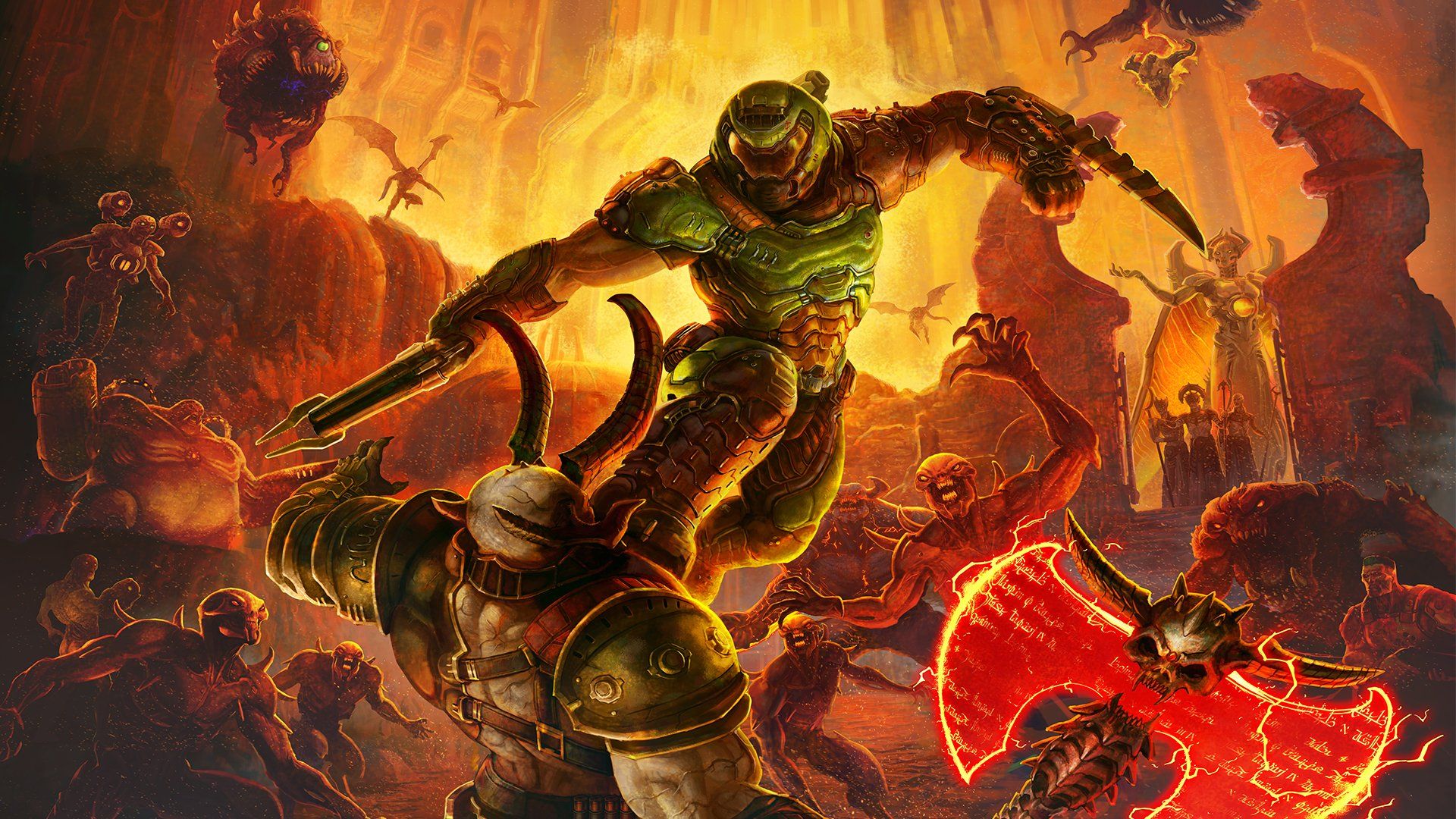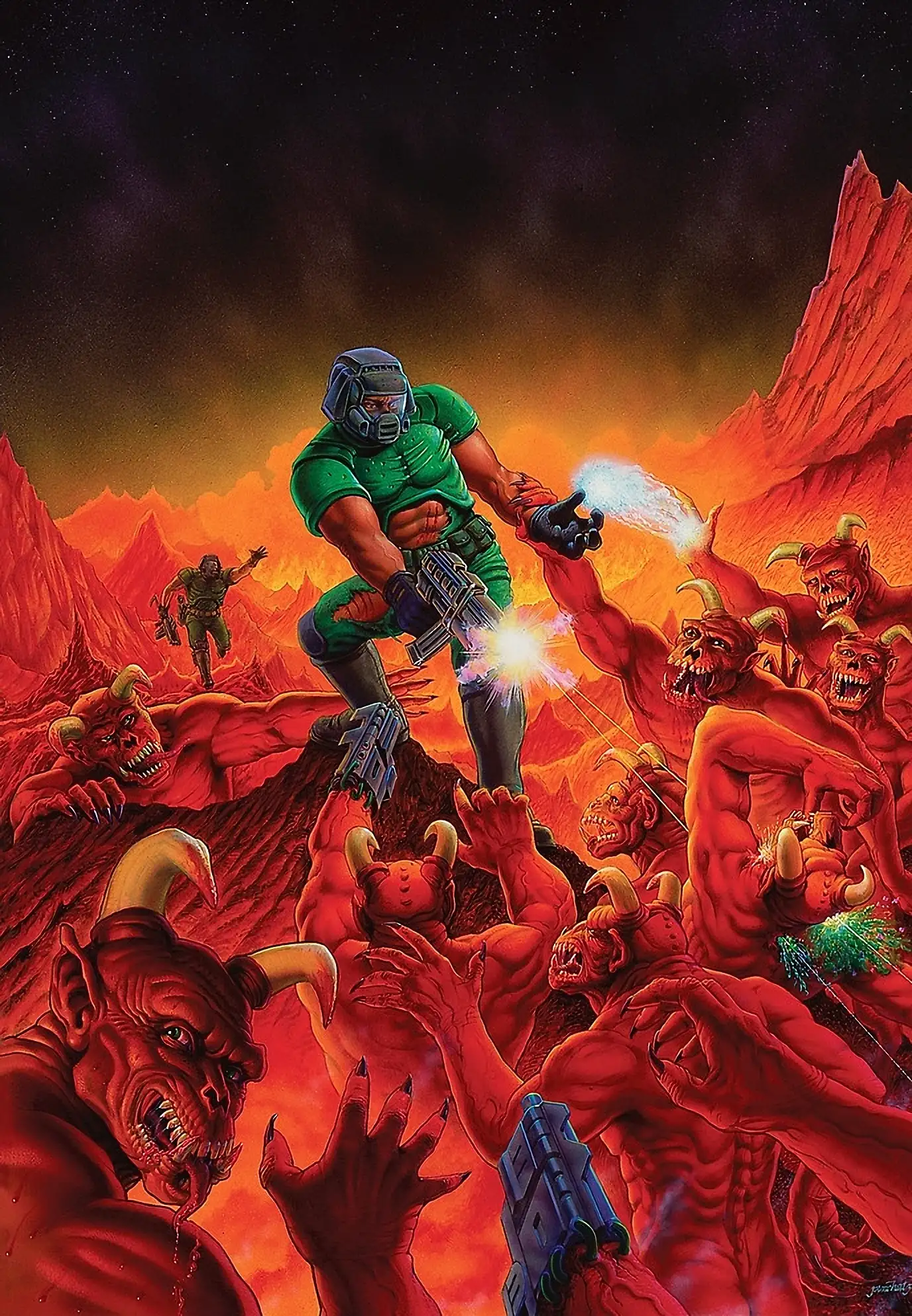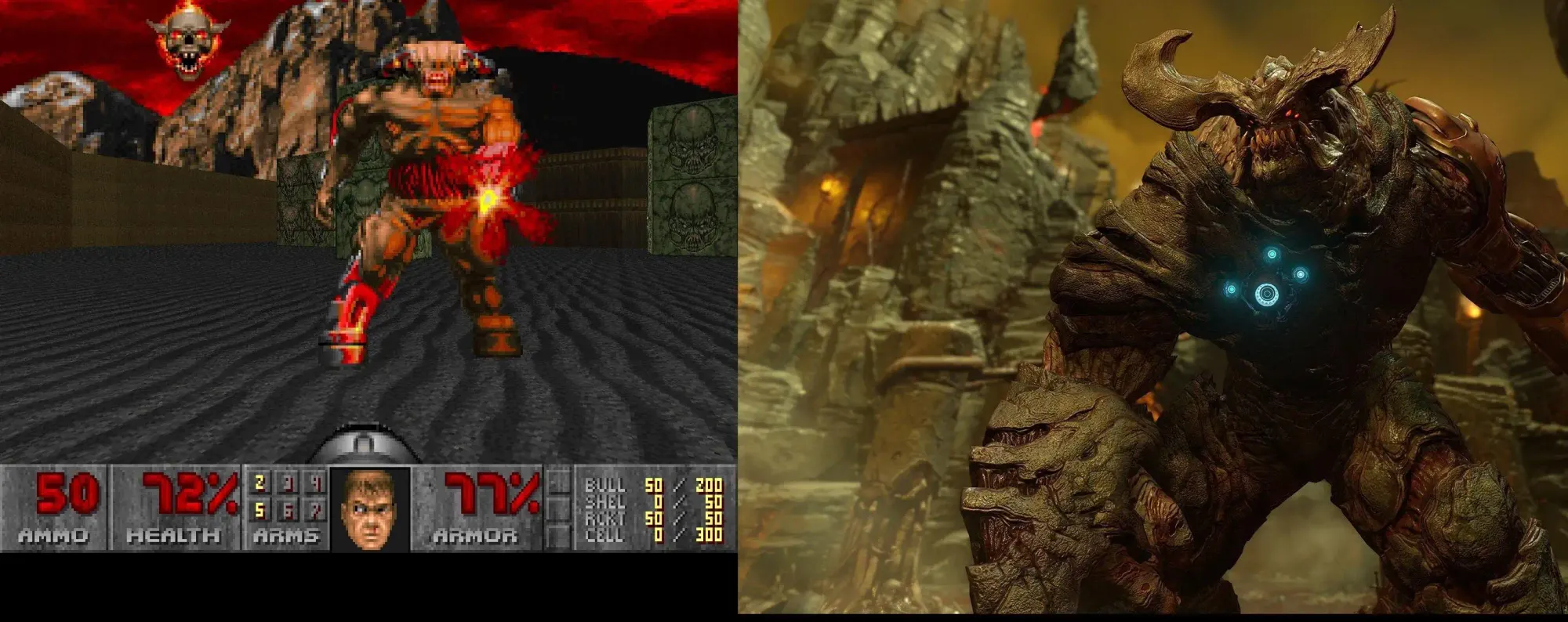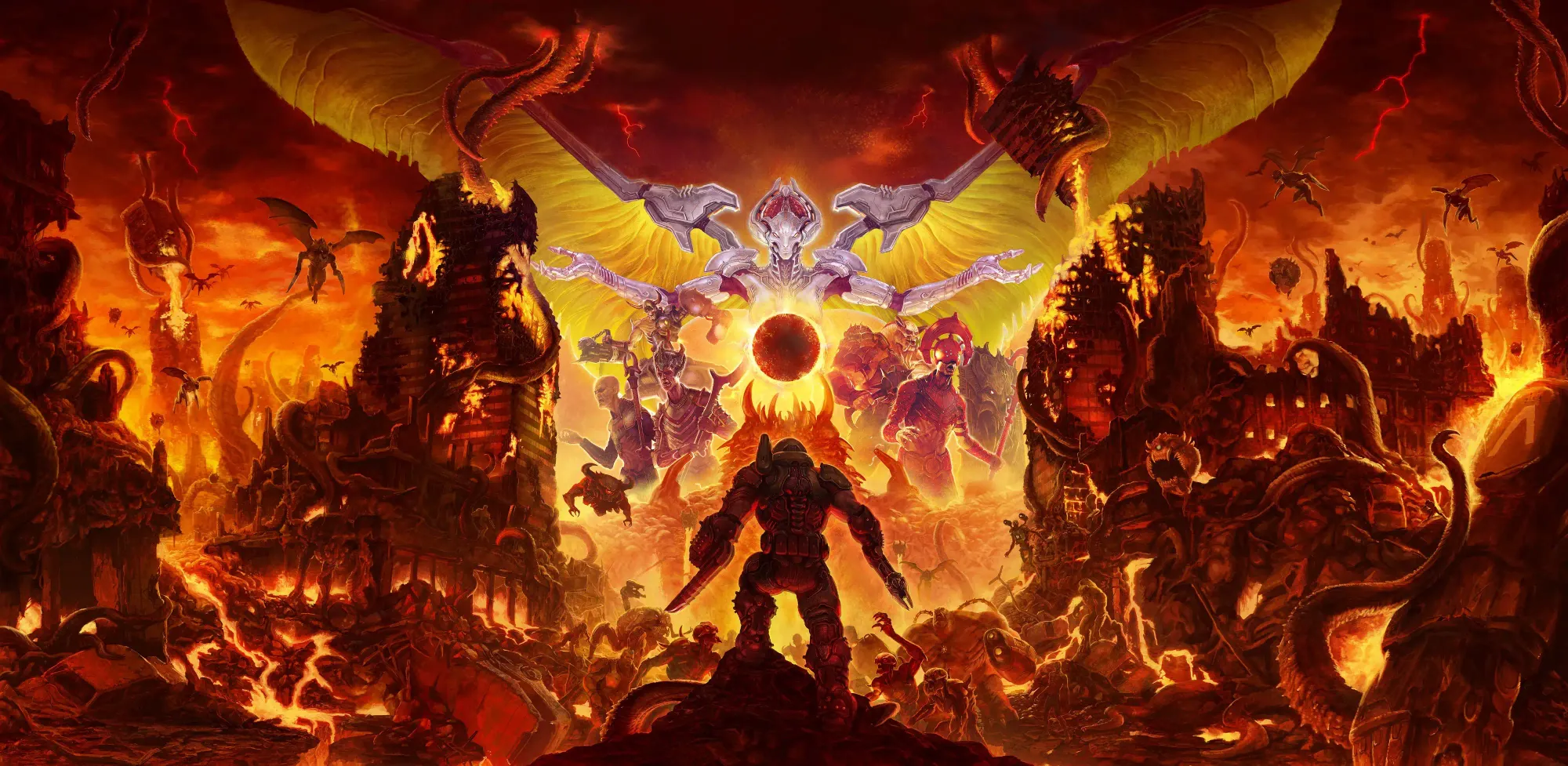Rip and Tear: How Doom Changed the Gaming Landscape
The iconic franchise has a long history of innovation and controversy

Blood, gore, viscera, shotguns, demons, chainsaws, violence, and heavy metal. These staples encapsulate what is means to play a game in the Doom series. From the classic Doom to the divisive Doom 3, all the way to the upcoming Doom: Eternal, these games have been monolithic in defining what video games are and what they can do. It would be difficult to argue that the modern day first person shooter (FPS) genre would have become what it is if Doom had never existed. From Quake to Turok, Half-Life to Bioshock, gaming has been molded by the steps Doom took to create one of the most visually appealing, mechanically engaging, and downright visceral gaming experience gamers had ever seen. Nearly three decades later, the series is still going strong, and the echoes of the original Doom’s rise to prominence can still be heard every time you boot up a game that plays from a first person perspective. Every legend has a beginning however, and the Demonslayer is no exception.

Doom was released on December 10th, 1993 in a relatively non-traditional fashion. Instead of hitting store shelves, a shareware copy — subtitled “Knee Deep in the Dead” — was uploaded to an FTP (file transfer protocol) server at the University of Wisconsin. The first episode of the iconic series was free to download, and an estimated 20 to 30 million computers had the software downloaded onto it. Those numbers may seem small by today’s standards, but considering the state PC gaming was in in the early 1990s, it’s astronomical. The other four episodes were sold for $9 a piece, resulting in an estimated $100,000 per day net sales for id Software. That’s roughly $178,000 per day by 2019 standards. A phenomenon that large was bound to change the market and how the world saw video games as a whole, and change them it did.
One of the first things that set Doom apart from other games at the time was its distinct level design. Instead of incorporating being singular or multiple linear paths between point A and point B (as seen in games like the popular Sonic the Hedgehog, which came out two years prior), Doom’s iconic first level was built almost like a horseshoe. Known as E1M1: Hanger, this peculiar level design encouraged exploration, tantalizing players with three secrets to find, along with an abundance of enemies to slaughter and guns to collect. It causes Doom to have a near-metroidvania (a typically side-scrolling action-adventure game term) feel, allowing the player to backtrack through the level in order to find all the nooks and crannies it has to offer. E1M1: Hangar is a notoriously iconic level, and can be traced to the roots of many of the level designs we take for granted today.

While it may not look like much today, especially compared to jaw-dropping graphical epics such as Red Dead Redemption 2, Doom was a graphical colossus in 1993. At that point, most games were still on a 2D plane with titles like The Legend of Zelda and Super Mario being the dominant force within the industry. While games such as Alone in the Dark and id Software’s own Wolfenstein 3D were built to be explored in three dimensional space, no game gave the feeling of confusion and exploration like the labyrinthian levels of the original Doom. Small, tight corridors could cause disorientation and claustrophobia, with enemies and secrets around every corner, leading to massive open areas filled with demons, guns, bullets, and lava. It gave the players the feel of randomly generated levels long before they were an industry standard. Despite the perceived insanity, each level is laid out meticulously, as to draw the player in. The 3D levels were unprecedented at the time, with many marvelling at the detailed sprites, massive level design, and sprouting gore.

Where FPS games such as Wolfenstein 3D are criticized for having repetitive corridors and tedious enemies, Doom had variation in both. The vistas were so wide-ranging that they included even Hell itself. As for enemies, the demons (known as “Hellspawn,”) vary wildly in size, danger, and fortitude. There are ten enemy types to slay in the original Doom, from gun-toting zombies to a massive machine-demon hybrid named the Cyberdemon. Each Hellspawn, and the intermingling combination of them, pressures the player into adapting their attack style to best the sometimes overwhelming amount of sprites on screen. While a cursory glance may suggest the gunplay is simply, “point at demon, press shoot,” in all actuality you have to plan which ammo to consume, which Hellspawn to focus on first, and how you can keep moving throughout the treacherous environments without falling into a pit of lava or other deadly floor trap. It allows for a surprisingly non-linear experience to the gameplay, especially on your first time through.
That innovative level design didn’t just affect the solo experience of eviscerating the demons from Hell as the lone Space Marine. When an online gamer hears the term “Deathmatch,” the picture they get in their mind’s eye is probably determined by how old they are. If you’re in your 20s or 30s, most likely your initial memory is that of the Halo series or perhaps Call of Duty 4: Modern Warfare. A little older and maybe you’re thinking of rocket jumping through maps in Quake. Regardless of what your first entrance into online gaming may have been, it wouldn’t have existed quite how you remember it if Doom hadn’t come along. The phrase “Deathmatch” was even pioneered by Doom which — despite it being the early ‘90s and internet connections being slower than a Mancubus — allowed players to compete in online matches over local servers as well as having local cooperative play. In Doom’s deathmatches, players were awarded a “frag” with each kill they got, losing a “frag” every time they accidentally killed themselves, spawning in a random location after each death to get back into the fray. At the conclusion of the match, a screen renders showing the “frag” count of each player. Sound familiar? That’s because Doom’s multiplayer has been used as a baseline for most deathmatch series in games since its inception. It cannot be overstated how much influence this multiplayer experience had on the gaming scene as a whole.

Anyone who has gamed on a PC has most certainly dabbled in the world of game mods. A mod is defined as the creation of custom levels, objects, characters, or even a unique or stand-alone game from an existing game engine. One of the most notorious mods is the utterly memeable “Thomas the Tank Engine” mod from The Elder Scrolls V: Skyrim, which turn all the dragons in Skyrim into Thomas the Tank Engine. Fully released games include the likes of DayZ, which was an Arma II mod, and Counterstrike, the massively popular competitive shooter being a mod from the original Half-Life. Modding is a staple of the PC gaming community, and it actually hails from the original Doom. id Software fully embraced the modding community, going as far as releasing the original source code for Doom in 1997. To this day, people are still modding the original game, taking the Doom Engine as far as it possibly can with mods like Valiant — giving Doom 32 massive levels including outer space — and OverDoom— in which weapons from the popular Blizzard game Overwatch can be used against the Hellspawn. There doesn’t seem to be any signs of the community slowing down either, and even though it’s been nearly three decades since the release of Doom, it continues to prove itself as a veritable playground for tech savvy individuals to test their skills and make something incredibly interesting and new.
Not everything was maroon-splattered flowers and blood red rainbows for the franchise, however. As was a trend with influential games of the ‘90s, Doom’s legacy has a trail of controversy that still continues today. In 2011, CNN rated Doom the third most controversial game ever released, behind only Mortal Kombat (1992) and Death Race (1976). With its “unbelievably realistic” graphic violence, copious amounts of blood and gore, and worst of all, genuine Satanic imagery (you literally kill demons from Hell), Doom was a hotbed for worried parents attempting to protect their children from the horrors of video games. Not only was the game condemned by the Church for its satanic imagery, it was infamously banned from Germany in 1994, stating it would “harm the youth” of the country. The ban stayed in effect until August 31st, 2011, with part of Germany’s reasoning for lifting the ban being that Doom was now “mainly of historical interest.” They stated that children are much less likely to play Doom in today’s day and age, and although they lifted the ban, you still have to be over 16 to purchase it. The controversy wasn’t what made the game popular, however. The game’s popularity preceded itself, going as far as many offices banning it from being played on their premises. Networks were clogged up entirely due to deathmatches and downloads, as well as productivity being slowed in many prominent tech companies. Former Microsoft employee and original DirectX developer Alex St. John equated Doom to a “religious phenomenon” throughout Microsoft’s offices, saying Microsoft employees “worshipped the game.” With the demand for the game being so high, it was inevitable that controversy wouldn’t be very far behind. Despite all the heat thrown its way, Doom persisted, and became one of the most popular games of the early ‘90s.

Love it or hate it, it’s difficult to argue that the wonderful world of video games would be anything close to what it is today if the Doom franchise didn’t bloody up our screens in the bygone era of the ‘90s. With its unique level design, challenging and varied enemies and weapons, and addictive gameplay loop, Doom showcased the potential video games had, as well as demonstrating that they aren’t just a pastime for children, but a competitive and fun experience for children and adults alike. It’s a franchise that — outside of the divisive Doom 3 — stayed the course and continually delivered the experience players were yearning for with each release. It wears its controversial roots on its sleeve, leaning into its splanchnic gore and fast, violent, and intuitive gameplay.
